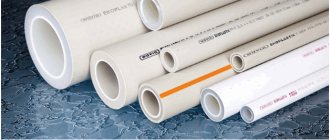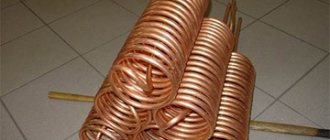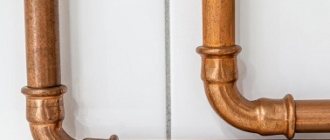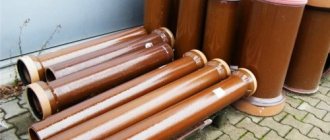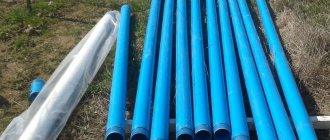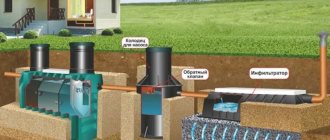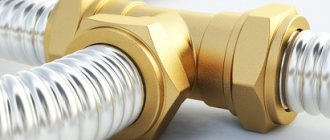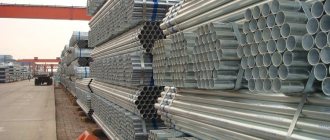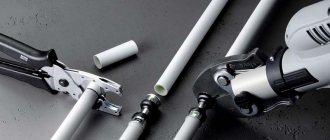A “pipe-in-pipe” heat exchanger, designated “TT”, is a heat exchanger consisting of two pipes of different diameters, mounted one inside the other. One smaller diameter pipe is placed and secured in a larger diameter pipe. As a result of this arrangement, the 1st channel is formed in a narrow pipeline and the 2nd - with a concentric cross-section. During operation, one of the media flows through the inner pipe, the other circulates through the annular space and is protected from the outside by a tubular casing.
Heat exchangers allow heating or cooling of the processed product, hot water or steam by transferring or removing heat between two pumped agents. During the pumping process, there is no mixing of the media (with the exception of the mixing structure), and each of them is isolated from the surrounding atmosphere.
As a type of thermal equipment, CTs are characterized by simple functionality and are reliable in operation. Thanks to these qualities, combined with the “democratic” price of the products, they are widely used in heating engineering. For their ability to independently manufacture simple welded structures and ease of maintenance, they are recognized among the “operators” of heat supply systems.
Components and Specifications
Heat exchangers are a one-to-one installation of 2 pipes of different diameters. The inner tube has a smaller diameter d and is called “heat exchanger”, the outer one with diameter D is called “shell”. Products are manufactured in accordance with TU 3612-014-00220302-99. Heat exchange devices are produced by manufacturers in the following standard sizes and have the following technical characteristics:
Depending on the purpose, heat exchangers are divided into heaters and refrigerators . The combination of individual heat exchange devices is carried out by connecting the shell pipes with rolls and butt jointing the heat exchange pipes into flow paths. After this, they are connected separately to their own circuit of the technological system or heating network.
Disadvantage of the “budget advantage” of the device: how to eliminate it?
However, while noting the low cost of the heat exchanger as an absolute advantage, we must not forget about the “other side of the coin.” Simple designs of heat exchangers are inferior to more expensive analogues in terms of thermal characteristics. It is enough to compare the TT with other shell-and-tube devices, of which, strictly speaking, it is a low-budget variety. As the wisdom says: “If it has increased in one place, it will decrease in another.”
In this case, the weakness of the “pipe-in-pipe” design was manifested in the insufficient heat transfer surface area of smooth pipes, which limits the use of the agent in gas-gas/gas-liquid pairs. With reduced installation costs, the use of such devices increases costs during the operation of thermal equipment.
However, there are a number of preventive measures and design modifications, the effect of which, if not completely eliminating the cavity, then significantly levels out this disadvantage. They especially intensify heat transfer in systems pumping “liquid-liquid”, significantly reducing the cost per unit surface of the process:
• selection of coolant with high specific heat capacity;
• use of counterflow agents (pumping flows in counter directions);
• the use of pumps/compressors along with convection to transport coolant at a speed of up to 3 m/s;
• increasing the inter-pipe annular space in products up to 20–30 mm:
• localization of finned and studded pipes with an increased area of contact with the coolant;
• use of flow reversal for periodic cleaning of the annular space and heat exchange pipes from contamination.
Design features of heat exchangers
The reliability of heat exchangers made of the pipe-in-pipe type and the ease of their operation are based on factors such as:
- compensation of temperature deformations;
- density and strength of detachable flange connections;
- ease of maintenance of the unit.
Heat exchanger
The main element of this type of heat exchanger is a device that consists of two pipes of different diameters.
The significant difference in diameter allows one pipe to be inserted into another along the longitudinal axis, leaving a gap between the walls of the pipes for the free movement of the coolant. Connection to the system ensures constant countercurrent flow of the processed product and hot water, steam or cold brine.
The heat exchanger design consists of several straight sections of pipes located one above the other. Internal pipes with a smaller diameter are connected in series to each other by arcs in a semicircle (transition channels), which are secured with a flange connection. The connection of the external pipes is made with special pipes, allowing the product to move freely throughout the section. The size of pipe elements and their number in one link can be different, which is determined primarily by the required performance of the heat exchanger.
What coolant should I use in the unit?
If the coolant is not a processed product, and its choice is not clearly provided for by the technological process, various liquid and gaseous agents can be used. In DHW or steam-gas heating systems adapted to a specific medium, the following coolants are combined with equipment. They are arranged in descending order of frequency of use in units of this type:
• water as a coolant with low viscosity and high specific heat capacity of 4.2 kJ/kg * °C is optimally suited for this type of thermal apparatus;
• water vapor has a high specific heat content; when cooled to 100°C and transformed into another state of aggregation, it releases 2260 kJ/kg of released energy (latent heat of condensation);
• flue gases are formed as a result of the combustion of solid or gaseous fuel, they require large heat transfer surfaces, therefore the use of an agent in this type of heat exchanger is not so effective during recirculation;
• high-boiling industrial coolants with a boiling point of up to 420°C and “anti-freeze” (antifreeze, ethylene glycol, glycerin, organic and mineral oils) have high heat transfer, but some require additional costs for pumping in the hydraulic path due to increased viscosity;
• heat exchangers are often charged with a diphenyl mixture based on 26.5% diphenyl and 73.5% alcohol of the same name; it is used in 40% of technological installations and is a transparent liquid of a specific amber color with a high heat capacity.
In heating systems, the viscosity of the coolant is often the determining parameter in favor of choosing one or another coolant. Due to the serious costs of additional installation of compressors and pumping equipment, and the high cost of electricity consumed for pumping the agent, this cost item significantly affects heating tariffs.
Therefore, not only the design capabilities of thermal units for the use of one or another agent are taken into account, but the efficiency of the heat supply system is also calculated. Particular attention is paid to this when installing individual heating points (IHP) of private households and boiler rooms of multi-apartment residential buildings (MCD).
Product manufacturing options
Modern devices are produced on high-tech equipment using automated high-precision welding lines. In the manufacturing process, high-quality steel of various grades is used.
It is resistant to reagents and aggressive working environments. The complex technological process involves the use of innovative materials and components in the design.
There is a version of products “U” for moderate and “T”, intended for use in tropical climates. All CTs, without exception, can be located in zones with 7-point (on a 12-point scale) seismicity. The entire territory of the Russian Federation, with the exception of 3 regions, is located in a zone of moderate seismicity, not exceeding these values. Depending on the type of device, the assigned service life of the devices ranges from 5 to 12 years.
Heat exchange devices are available in the following versions:
1. with twins welded on the product;
2. with removable unit twins.
General information about pipe-in-pipe heat exchanger
With the help of heat exchangers, or heat exchangers, thermal energy is exchanged between two substances used as a coolant. This leads to heating of one of them and cooling of the other. Based on this ability, some heat exchangers on heat pipes act as heaters, others as refrigerators.
The method of heat transfer by devices can be:
- Superficial . Serves to separate the coolant. In this case, a special wall is provided that conducts heat well between the two compartments of the tank.
- Regenerative . The heat transfer procedure includes two stages, during which a special nozzle is alternately heated and cooled.
- Mixing . For heat exchange between two media, their direct contact and mixing are used.
Types of TT devices
By type, heat exchangers are divided into:
• TTON – single-shelf non-removable. There is a version with welded twins. It is designed to operate in a deposit-free environment in the concentric space and inside the heat exchange tubes. Therefore, they are compatible with clean coolant and process media. In devices with a removable twin, a cleaning operation is provided.
• TTOR – single-shelf, collapsible, designed for transportation and heating of heavily contaminated media. They operate in wastewater treatment plants with a liquid agent flow rate of up to 60 t/hour, and in a steam heater for moderately contaminated product. The design provides for thermal elongation of heat exchange pipes at temperatures up to 150°C.
• TTM – multi-flow collapsible are used for convective heat exchange, condensation or evaporation of working media. Indispensable in working conditions aggravated by high viscosity. Used in installations with high throughput up to 300 t/hour. To intensify heat transfer, pipes with longitudinal ribs or studded pipelines are used.
• TTRM – low-flow collapsible, indispensable in systems with relatively low agent consumption from 100 to 15,000 kg in the pipe space.
They are used in laboratory and pilot installations (oil coolers, fuel oil heaters). Condensation/evaporation processes in concentric space are used.
Heat exchanger calculation
The heat exchanger is designed based on:
- Thermal calculation with determination of the surface areas of the heat exchanger,
- Constructive calculation of the main geometric parameters of the unit and its components,
- Hydraulic calculation determining pressure loss,
- Calculation of thermal insulation of equipment,
- Calculation of economic efficiency.
Heat exchanger pipe in pipe
Heat exchanger specifications can vary greatly depending on the application, model, and process needs of the line or system. When calculating the unit, its main purpose is taken into account - the exchange of thermal parameters of the coolant and the processed medium. Based on the physical properties of coolants, a pipe-in-pipe heat exchanger is calculated taking into account the various characteristics of the unit and the system as a whole. To do this, the following parameters are assessed:
- level of heat loss,
- technological and thermal diagram,
- a set of associated factors,
- coolant flow is set,
- the values of the initial and final temperatures are determined,
- the thermal load is determined,
- a balance of system performance is compiled.
In addition, it is necessary to take into account the degree of aggressive influence of the environment on the material from which the heat exchanger is made, toxicity and physicochemical properties. An important part of the calculation is determining the direction of movement of the coolant.
The most preferable option is the countercurrent direction of movement, since this makes it possible to increase thermal performance by reducing the working surface of the equipment.
With countercurrent movement, temperature differences in coolants increase, energy consumption decreases. The procedure for calculating the performance of heat exchangers is considered a complex technical task, therefore, in order to make a “pipe-in-pipe” heat exchanger with your own hands, you will need not only desire, but also a fairly large amount of professional knowledge.

